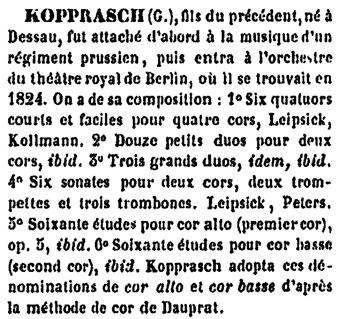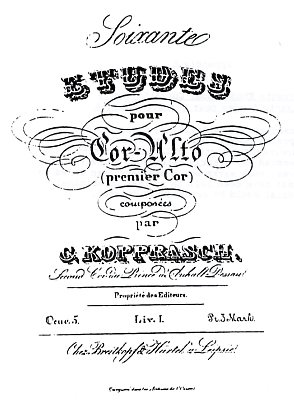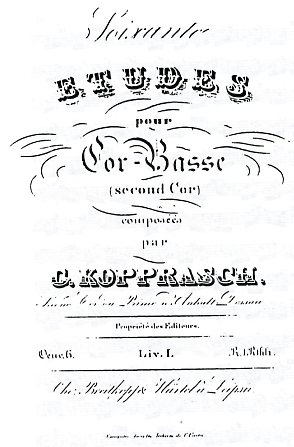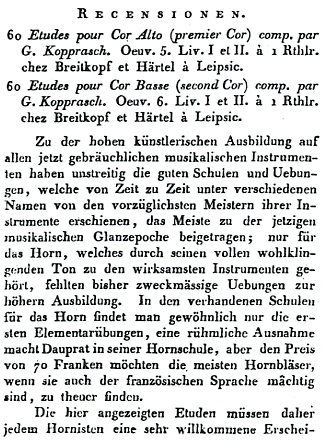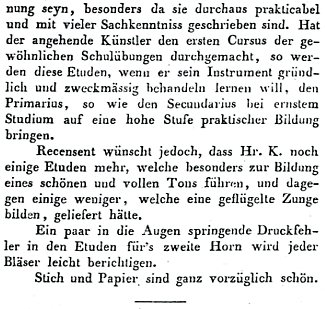|
Label: |
(none) |
|
Model: |
(single) |
|
Serial Number: |
none |
|
Date of Manufacture: |
ca. 1840? |
|
Key(s): |
F |
|
Valves: |
3 Berliner pumpen |
|
Bore: |
11.43 |
|
Mouthpipe Socket: |
8.6 mm |
|
Bell Flare: |
gusset |
|
Bell Throat: |
approx. 9 cm. |
|
Bell Diameter: |
28.1 cm |
|
Base Metal: |
brass with nickel silver trim |
|
Finish: |
raw brass |
 |
||
This horn and incorporates "Berliner-Pumpen" valves following
a design of the Berlin firm of Johan Gottfried Moritz (1777-1840) or his son and successor Carl Wilhelm Moritz
(1810-1855). A horn similar to the one shown here
is cited by Heyde ((1987, e.g. p.120, foto 13) from the workshop of J.G. Moritz having
as having been made ca. 1835-1840. Dr. Heyde suggests,however, that the horn shown here
was not made in the Moritz Berlin workshop but more likely in by another maker in Markneukirchen or Grazlitz perhaps"in the 1850s or 60s. He agrees that it is
certainly based on the Moritz model.
The Berliner-pumpen valve design has long been attributed to the famous Berlin bandmaster,
Wilhelm Wieprecht (1802-1872), as an improvement over the original Stoelzel/Blümel
piston valves. According to Heyde (1987, p23), however, it was in fact
Johann Heinrich David Stoelzel (1777-1844)
himself who perfected the design of the fat, stubby piston in 1827 but failed
to obtain a patent. The long-standing confusion stems from an article that Wieprecht
wrote for the Berliner Musicalische Zeitung in 1845 (see Baines, 1976, p. 207ff, and Tarr, 1993, p.231)
in which he claimed the invention was his own. Wieprecht applied for a similar patent
in 1833 but was also rejected. According to Baines (1976, p.211) Wieprecht obtained the
patent for his Steckerbüchsenventile ("pin capsule valves") in
1835. The main difference in the two designs
is in the arrangment of the ports, the attached slide, and
the shape of the airways on the internal piston.
In Stoelzel's
Röhrenventil configuration the slide legs are both ported
to the valve casing on the same side.
It is not known whether Stoelzel's piston was a rectangular box or cylindrical.
In Wieprecht's Stecherbüchsen-Ventil,
the "slide" was attached to opposite
sides of the cylindrical casing and was often a simple fixed curved loop of tubing. As such it was not capable of
having an adjustable slide. (The adjustable slide, however, is an improvement attributed to Joseph Meifred in Paris.)
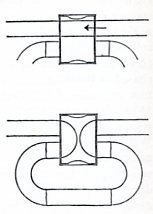 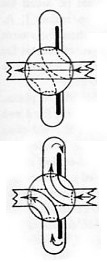
The valves on this horn are of a later pattern of the "Berliner pumpen" design having cylindrical casings with adjustable slides attached on one side similar to modern brass instrument rotary valves. The Berliner-Pumpen valve has been primarily associated with band instruments and is quite uncommon on orchestral horns such as this. Berliner valves appear in many instrument catalogs in the second half of the nineteenth and early twentieth century primarily on lower brass instruments, Sax horns and some cornets. Another curious characteristic of this horn is its dimensions. While the bore and mouthpiece receiver are of normal size for German instruments, the smallish bell flare is coupled to a disproportionately huge bell throat. As a result it is a very free blowing instrument with dark tone and a solid and very robust low register. |
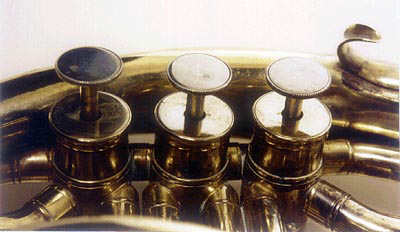
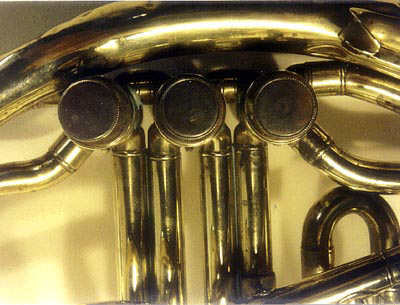
|
|
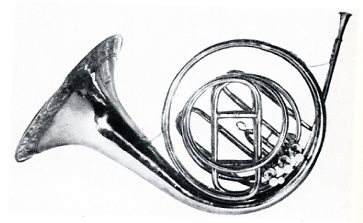
Baines, 1966, plate 786 and pp. 146, 148 |
This instrument by J. G. Moritz, Berlin, in the collection of Institut für Musikforschung, Musicinstrumenten-Sammlung, Berlin (no. 4366), is similar to the subject horn. Heyde (1987, p. 130) gives the date as 1835-1840 several years after Wieprecht applied for a patent for his Stecherbüchsen-Ventil. Indeed, the valves on this horn are of the Berliner design and the valve section is removable so it may be played as a natural horn. The main tuning slide follows the valve section the same way as on the subject horn. The bore is somewhat smaller at 1.03 cm and the bell flare is somewhat larger at 29 cm. The mouthpipe socket is approximately the same at 8.7 mm. This horn is unusual in that the third valve lowers the pitch by a whole tone slightly more than the first valve instead of the customary tone and one half. This is the same curious arrangement as another anonymous horn in this collection. | |
| The first valve slide has an unusually wide profile similar to the Moritz horn shown above. The very distinctive wrap of the third valve slide is quite different from the Moritz horn because in this case it is a standard one and one half tone descending valve. The large loop is soldered directly to the the lead pipe which wraps all the way around the horn to the first valve. The lead pipe is also soldered throughout directly to to the first branch and bell tail. There are only three braces to the valve section on no braces on the valve tuning slides themselves. |
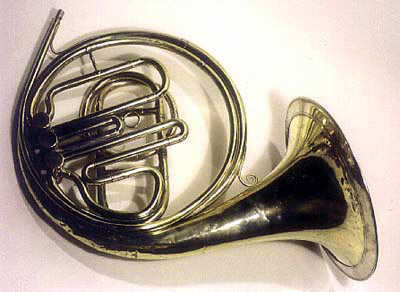
|
|
| The Berliner valves are mounted perpendicular to orientation of the more common Périnet piston valves This allows the valve slides to lie in the same plane as the rest of the horn in the same manner as rotary valves and without the additional sharp bends of the Perinet design. One drawback of the Berliner valves is that they protrude far below the edge of the bell tail where they prevent the player's hand from wrapping all the way around. |
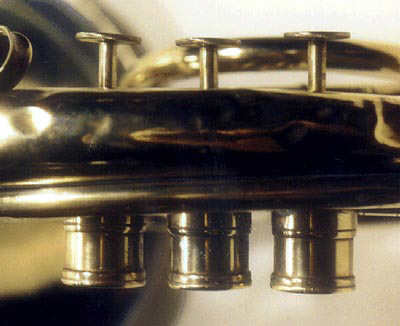
|
|


|
||
